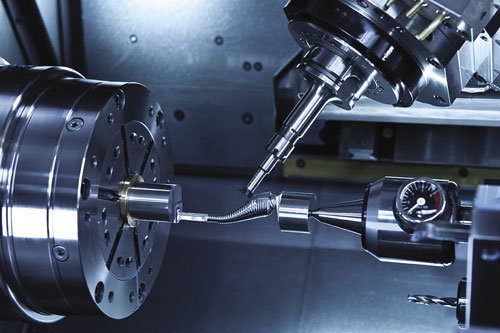Producing a new medical implant can take 12 to 18 months from the first drawing, including the design and job planning, through to the completed, approved product.
Substantial legal requirements complicate functional specifications for the implant manufacturers. From the design, including the materials, through production, the complete process chain must be documented and validated.
Artificial bones made of titanium are mainly manufactured using the stock-removal process. At implantcast, for example, the production of hip implants runs on DMG turning-milling centers equipped with the Siemens CNC Sinumerik 840D sl. Each implant also has an associated, specially tailored set of instruments required for the implantation. This includes, for example, a surgical rasp used to prepare the bone.

DMG turning-milling centers equipped with the Sinumerik 840d sl CNC controller technology.
Because its powerful machine functionality is suitable for both complex single parts and large production runs, not only the quantity production, but also the production of one-offs runs on the same machine. The fast data processing of the 840D sl is a particular advantage for the standard implants produced in quantity. In this case, the implants and instruments are cut perfectly to the associated bone structure with the help of a CT or MRI picture. For this single part production, implantcast uses the comprehensive setup functions of the Sinumerik for fast machine setup.
The CNC user interface has self-explanatory icons that can be configured as popular keys. These measuring functions can be used both for the setup and process measurement, that is, the overall quality assurance during the machining. The Sinumerik Operate user interface also integrates simple swivel commands that simplify the machine setup. The Cycle 800 swivel cycle functions are available both for the swiveling in a machine axis and in an axis of the workpiece coordinate system. The CNC also handles any required coordinate transformation immediately.

Bone rasps are supplied to orthopedists with the joint implants for the proper preparation of the bone.
The 840D sl provides a comprehensive range of powerful turning and milling cycles. Because all operator functions and cycles are supported with animated elements, the operator will know how functions are to be used, without needing to consult the instruction manual. Dynamic vector graphics can be used when the animated elements do not explain the purpose of the individual input values, such as the parameterization of complex cycles. These graphics reflect the current input values with their proportional representation.
The 840D sl offers a program simulation that shows the stock removal process in virtual 3D. In addition to the complete representation of the cutting actions, the expected machining time corresponding to the programmed technology values is also displayed, before the production of a single workpiece.
The turning-milling center of the 840D sl used at implantcast, with cross slides for Y and B axes, permits five-axis simultaneous machining. The implants are manufactured in a single operation, with parallel machining on the main and counter spindles. For the complete machining, the 840D sl provides turning-milling functions that can be used in combination.

Sinumerik 840D sl with the Sinumerik Operate user interface:
Dual-channel representation in the CNC simulation brings transparency to the programming and the setup, even for complex workpieces.
Bone rasps are an example of very complex workpieces, because the basic form represents a significant challenge in machining, namely, a rasp body with many rasp teeth located on the contoured outer surfaces. The MDynamics technology package ensures the required surface quality at high machining speed even for difficult materials. The Advanced Surface motion control produces milling results that meet the stringent requirements placed on medical implants and instruments.
Each individual part is subjected to a comprehensive quality control. Sensing probes check the accuracy of the contour and the peak-to-valley height and scan the surface for even the smallest damage. To check the material structure, X-ray examinations are also made on some parts. Only when all these hurdles have been overcome are the implants passed to the internal department at implantcast for sterile packaging and subsequent shipping.
Siemens, Inc.
www.siemens.com
Filed Under: Medical-device manufacture, Materials • advanced





Tell Us What You Think!